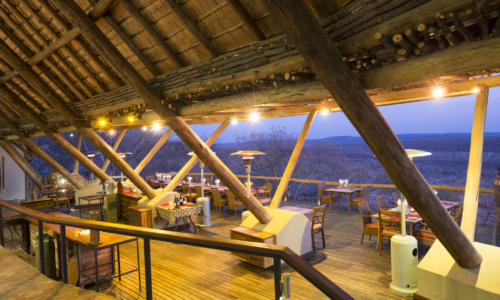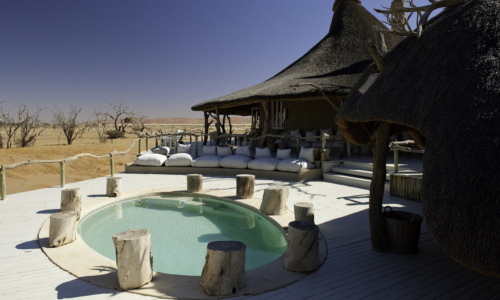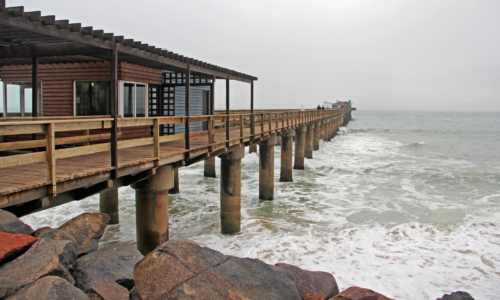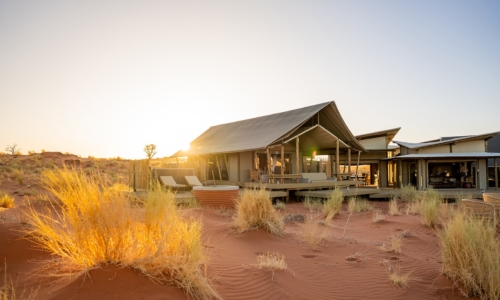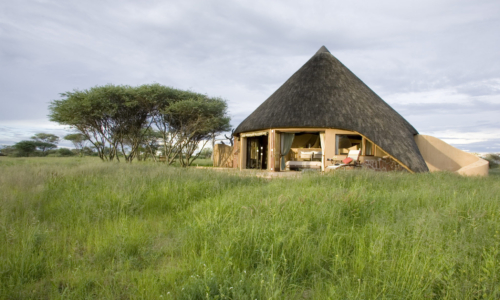Run by Arno and Estelle Oosthuysen, Nhoma has ten tents built on wooden decks. Three of the tents have double beds with a corner bath and a partition bathroom. Two tents have a double and a single bed and corner bath. One tent has a double and a single bed and shower in the bathroom partition. And the remaining four tents have twin beds with showers. Each tent has a private veranda, solar lighting, and mosquito netting. In a wonderful touch, all the furniture was made by Arno with the help of the community. Throw rugs decorate the floors while cream and brown linens with San motifs cover the very comfortable beds.
The camp is located near Khaudum National Park in a remote area of Namibia. Khaudum encompasses nearly 1,500 square miles. Except for its border with Botswana, the park is not fenced, and game migrates freely into the neighboring conservancies. Northeastern Namibia’s unique woodland savanna biome is the habitat for the endangered roan antelope. Wild dogs are also endangered and are usually only seen in September and October at waterholes. As the clay pans dry up toward the end of August, huge herds of elephants congregate at the waterholes estimates are as high as 3,500.
The Oosthuysen’s are intimately involved in the many cultural activities on offer, from hunting with the Bushmen to veld food collection to crafting hunting equipment to traditional games and dances. Guests are encouraged to spend most of their time with the local hunters, three or four men whose job it is to hunt in the traditional way and provide meat for the village. Every hunt is guided by Arno, who also acts as an interpreter. Along the way, the native Bushmen teach about the area’s various flora and fauna. Other lessons include how to prepare hides, set traps for smaller animals, and craft arrows and quivers. In addition to hunting, there are other traditional activities in the village such as cooking, making crafts, and brewing medicines. In the evenings, a visit to local village lets visitors watch their traditional giraffe and elephant healing dances.
The camp is vital to tourism’s symbiotic relationship to the region. Guests are invited to visit this area, and the local the community is thereby enabled to buy food and supplies that they are not able to gather from the bush in their traditional way.

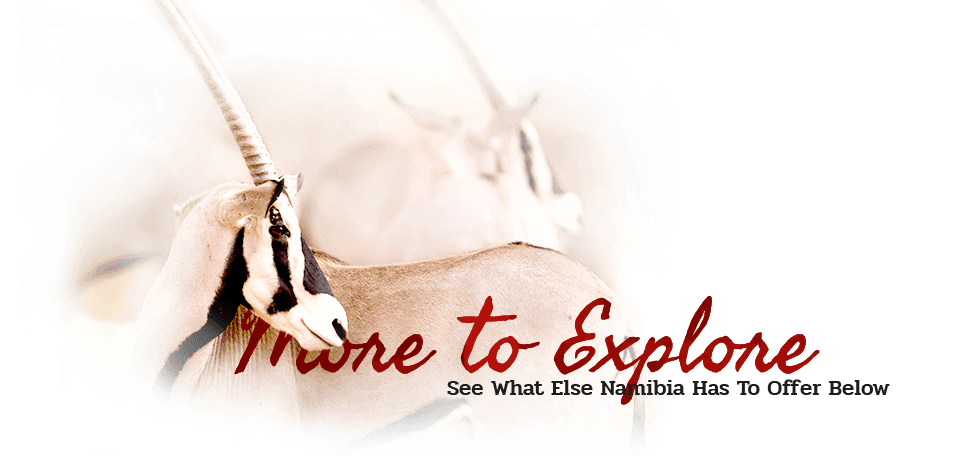
- Anderssons at Ongava
- Babson House
- Camp Kipwe
- Canyon Lodge
- Canyon Roadhouse
- Canyon Village
- Cape Cross Lodge
- Chobe Savanna Lodge
- Damara Mopane Lodge
- Damaraland Camp
- Dead Valley Lodge
- Desert Hills Glamping Camp
- Desert Homestead
- Desert Homestead Outpost
- Desert Rhino Camp
- Dolomite Camp
- Doro Nawas Camp
- Eagle’s Nest Lodge
- Erongo Wilderness Lodge
- Etosha Heights Safari House
- Etosha Mountain Lodge
- Etosha Safari Camp
- Etosha Safari Lodge
- Fish River Lodge
- Fort Sesfontein Lodge
- Grootberg Lodge
- Halali Camp
- Hoanib Elephant Camp
- Hoanib Skeleton Coast Camp
- Hoanib Valley Camp
- Ichingo Chobe River Lodge
- Kalahari Anib Lodge
- Kalahari Farmhouse
- Khorixas Rest Camp
- Kulala Desert Lodge
- Kwessi Dunes
- Little Kulala
- Little Ongava
- Malansrus Tented Camp
- Mowani Mountain Camp
- Mushara Bush Camp
- Mushara Lodge
- Mushara Outpost
- Naankuse Lodge
- Namib Desert Lodge
- Namushasha River Lodge
- Namutoni Camp
- Nhoma Safari Camp
- Nkasa Linyanti
- Okahirongo Elephant Lodge
- Okahirongo River Camp
- Okaukuejo Camp
- Okonjima Bush Camp
- Okonjima Bush Suite
- Okonjima Grand African Villa
- Okonjima Plains Camp
- Onduli Ridge
- Ongava Lodge
- Ongava Tented Camp
- Onguma Bush Camp
- Onguma Etosha Aoba Lodge
- Onguma Tented Camp
- Onguma The Fort
- Onguma Tree Top Camp
- Onkoshi Camp
- Ozondjou Trails
- Popa Falls Camp
- River Crossing Lodge
- Safarihoek Lodge
- Serra Cafema Camp
- Shipwreck Lodge
- Sossus Dune Lodge
- Sossusvlei Desert Lodge
- Terrace Bay Camp
- Teufelskrallen Tented Lodge
- Villa Mushara
- Wolwedans Boulders Camp
- Wolwedans Desert Lodge
- Wolwedans Dune Camp
- Wolwedans Mountain View Suite
- Wolwedans Plains Camp
- Anderssons at Ongava
- Babson House
- Camp Kipwe
- Canyon Lodge
- Canyon Roadhouse
- Canyon Village
- Cape Cross Lodge
- Chobe Savanna Lodge
- Damara Mopane Lodge
- Damaraland Camp
- Dead Valley Lodge
- Desert Hills Glamping Camp
- Desert Homestead
- Desert Homestead Outpost
- Desert Rhino Camp
- Dolomite Camp
- Doro Nawas Camp
- Eagle’s Nest Lodge
- Erongo Wilderness Lodge
- Etosha Heights Safari House
- Etosha Mountain Lodge
- Etosha Safari Camp
- Etosha Safari Lodge
- Fish River Lodge
- Fort Sesfontein Lodge
- Grootberg Lodge
- Halali Camp
- Hoanib Elephant Camp
- Hoanib Skeleton Coast Camp
- Hoanib Valley Camp
- Ichingo Chobe River Lodge
- Kalahari Anib Lodge
- Kalahari Farmhouse
- Khorixas Rest Camp
- Kulala Desert Lodge
- Kwessi Dunes
- Little Kulala
- Little Ongava
- Malansrus Tented Camp
- Mowani Mountain Camp
- Mushara Bush Camp
- Mushara Lodge
- Mushara Outpost
- Naankuse Lodge
- Namib Desert Lodge
- Namushasha River Lodge
- Namutoni Camp
- Nhoma Safari Camp
- Nkasa Linyanti
- Okahirongo Elephant Lodge
- Okahirongo River Camp
- Okaukuejo Camp
- Okonjima Bush Camp
- Okonjima Bush Suite
- Okonjima Grand African Villa
- Okonjima Plains Camp
- Onduli Ridge
- Ongava Lodge
- Ongava Tented Camp
- Onguma Bush Camp
- Onguma Etosha Aoba Lodge
- Onguma Tented Camp
- Onguma The Fort
- Onguma Tree Top Camp
- Onkoshi Camp
- Ozondjou Trails
- Popa Falls Camp
- River Crossing Lodge
- Safarihoek Lodge
- Serra Cafema Camp
- Shipwreck Lodge
- Sossus Dune Lodge
- Sossusvlei Desert Lodge
- Terrace Bay Camp
- Teufelskrallen Tented Lodge
- Villa Mushara
- Wolwedans Boulders Camp
- Wolwedans Desert Lodge
- Wolwedans Dune Camp
- Wolwedans Mountain View Suite
- Wolwedans Plains Camp

Run by Arno and Estelle Oosthuysen, Nhoma has ten tents built on wooden decks. Three of the tents have double beds with a corner bath and a partition bathroom. Two tents have a double and a single bed and corner bath. One tent has a double and a single bed and shower in the bathroom partition. And the remaining four tents have twin beds with showers. Each tent has a private veranda, solar lighting, and mosquito netting. In a wonderful touch, all the furniture was made by Arno with the help of the community. Throw rugs decorate the floors while cream and brown linens with San motifs cover the very comfortable beds.
The camp is located near Khaudum National Park in a remote area of Namibia. Khaudum encompasses nearly 1,500 square miles. Except for its border with Botswana, the park is not fenced, and game migrates freely into the neighboring conservancies. Northeastern Namibia’s unique woodland savanna biome is the habitat for the endangered roan antelope. Wild dogs are also endangered and are usually only seen in September and October at waterholes. As the clay pans dry up toward the end of August, huge herds of elephants congregate at the waterholes estimates are as high as 3,500.
The Oosthuysen’s are intimately involved in the many cultural activities on offer, from hunting with the Bushmen to veld food collection to crafting hunting equipment to traditional games and dances. Guests are encouraged to spend most of their time with the local hunters, three or four men whose job it is to hunt in the traditional way and provide meat for the village. Every hunt is guided by Arno, who also acts as an interpreter. Along the way, the native Bushmen teach about the area’s various flora and fauna. Other lessons include how to prepare hides, set traps for smaller animals, and craft arrows and quivers. In addition to hunting, there are other traditional activities in the village such as cooking, making crafts, and brewing medicines. In the evenings, a visit to local village lets visitors watch their traditional giraffe and elephant healing dances.
The camp is vital to tourism’s symbiotic relationship to the region. Guests are invited to visit this area, and the local the community is thereby enabled to buy food and supplies that they are not able to gather from the bush in their traditional way.

- Anderssons at Ongava
- Babson House
- Camp Kipwe
- Canyon Lodge
- Canyon Roadhouse
- Canyon Village
- Cape Cross Lodge
- Chobe Savanna Lodge
- Damara Mopane Lodge
- Damaraland Camp
- Dead Valley Lodge
- Desert Hills Glamping Camp
- Desert Homestead
- Desert Homestead Outpost
- Desert Rhino Camp
- Dolomite Camp
- Doro Nawas Camp
- Eagle’s Nest Lodge
- Erongo Wilderness Lodge
- Etosha Heights Safari House
- Etosha Mountain Lodge
- Etosha Safari Camp
- Etosha Safari Lodge
- Fish River Lodge
- Fort Sesfontein Lodge
- Grootberg Lodge
- Halali Camp
- Hoanib Elephant Camp
- Hoanib Skeleton Coast Camp
- Hoanib Valley Camp
- Ichingo Chobe River Lodge
- Kalahari Anib Lodge
- Kalahari Farmhouse
- Khorixas Rest Camp
- Kulala Desert Lodge
- Kwessi Dunes
- Little Kulala
- Little Ongava
- Malansrus Tented Camp
- Mowani Mountain Camp
- Mushara Bush Camp
- Mushara Lodge
- Mushara Outpost
- Naankuse Lodge
- Namib Desert Lodge
- Namushasha River Lodge
- Namutoni Camp
- Nhoma Safari Camp
- Nkasa Linyanti
- Okahirongo Elephant Lodge
- Okahirongo River Camp
- Okaukuejo Camp
- Okonjima Bush Camp
- Okonjima Bush Suite
- Okonjima Grand African Villa
- Okonjima Plains Camp
- Onduli Ridge
- Ongava Lodge
- Ongava Tented Camp
- Onguma Bush Camp
- Onguma Etosha Aoba Lodge
- Onguma Tented Camp
- Onguma The Fort
- Onguma Tree Top Camp
- Onkoshi Camp
- Ozondjou Trails
- Popa Falls Camp
- River Crossing Lodge
- Safarihoek Lodge
- Serra Cafema Camp
- Shipwreck Lodge
- Sossus Dune Lodge
- Sossusvlei Desert Lodge
- Terrace Bay Camp
- Teufelskrallen Tented Lodge
- Villa Mushara
- Wolwedans Boulders Camp
- Wolwedans Desert Lodge
- Wolwedans Dune Camp
- Wolwedans Mountain View Suite
- Wolwedans Plains Camp
- Anderssons at Ongava
- Babson House
- Camp Kipwe
- Canyon Lodge
- Canyon Roadhouse
- Canyon Village
- Cape Cross Lodge
- Chobe Savanna Lodge
- Damara Mopane Lodge
- Damaraland Camp
- Dead Valley Lodge
- Desert Hills Glamping Camp
- Desert Homestead
- Desert Homestead Outpost
- Desert Rhino Camp
- Dolomite Camp
- Doro Nawas Camp
- Eagle’s Nest Lodge
- Erongo Wilderness Lodge
- Etosha Heights Safari House
- Etosha Mountain Lodge
- Etosha Safari Camp
- Etosha Safari Lodge
- Fish River Lodge
- Fort Sesfontein Lodge
- Grootberg Lodge
- Halali Camp
- Hoanib Elephant Camp
- Hoanib Skeleton Coast Camp
- Hoanib Valley Camp
- Ichingo Chobe River Lodge
- Kalahari Anib Lodge
- Kalahari Farmhouse
- Khorixas Rest Camp
- Kulala Desert Lodge
- Kwessi Dunes
- Little Kulala
- Little Ongava
- Malansrus Tented Camp
- Mowani Mountain Camp
- Mushara Bush Camp
- Mushara Lodge
- Mushara Outpost
- Naankuse Lodge
- Namib Desert Lodge
- Namushasha River Lodge
- Namutoni Camp
- Nhoma Safari Camp
- Nkasa Linyanti
- Okahirongo Elephant Lodge
- Okahirongo River Camp
- Okaukuejo Camp
- Okonjima Bush Camp
- Okonjima Bush Suite
- Okonjima Grand African Villa
- Okonjima Plains Camp
- Onduli Ridge
- Ongava Lodge
- Ongava Tented Camp
- Onguma Bush Camp
- Onguma Etosha Aoba Lodge
- Onguma Tented Camp
- Onguma The Fort
- Onguma Tree Top Camp
- Onkoshi Camp
- Ozondjou Trails
- Popa Falls Camp
- River Crossing Lodge
- Safarihoek Lodge
- Serra Cafema Camp
- Shipwreck Lodge
- Sossus Dune Lodge
- Sossusvlei Desert Lodge
- Terrace Bay Camp
- Teufelskrallen Tented Lodge
- Villa Mushara
- Wolwedans Boulders Camp
- Wolwedans Desert Lodge
- Wolwedans Dune Camp
- Wolwedans Mountain View Suite
- Wolwedans Plains Camp







